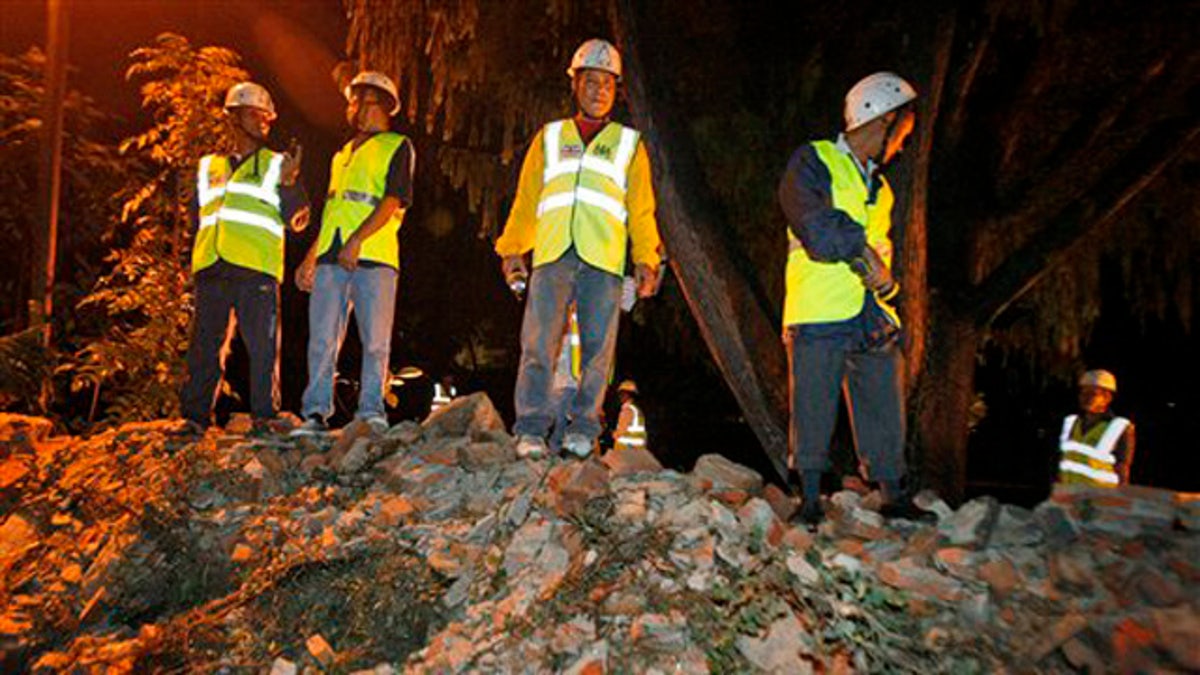
British Embassy staff look on after the embassy's compound wall collapsed reportedly killing three pedestrians following an earthquake in Katmandu, Nepal, Sunday, Sept. 18, 2011. (AP)
GANGTOK, India – Rescue workers in helicopters and earth movers raced Monday to reach Indian villages cut off by mudslides after a powerful earthquake killed 53 people and damaged more than 100,000 homes in the remote Himalayan region, officials said.
Three emergency workers were killed in the frantic, rain-soaked rescue effort. More than 6,000 troops worked to clear concrete slabs, bricks and mud to rescue scores of people trapped under houses that collapsed when the 6.9-magnitude quake struck the mountainous region Sunday evening.
Nine helicopters dropped food to villages, airlifted a medical team, evacuated the injured and conducted damage assessments, Indian Home Secretary R.K. Singh said. Heavy construction equipment was used to clear some of the blocked roads, he said.
"The rescue and relief operations are in full swing though they were hampered ... by poor weather," he said.
At least 32 people died and 100 others were injured in the northeastern Indian state of Sikkim, where the quake was centered near India's border with Nepal, Singh said. At least 10 of those killed worked for the same hydroelectric project, he said. It was not immediately clear how they died.
Seven other people were killed the neighboring Indian states of Bihar and West Bengal, he said. Seven people died in Nepal, and China's official Xinhua News Agency reported seven deaths in Tibet.
Most of the deaths occurred when houses, already weakened from recent monsoon rains, collapsed due to the force of the quake.
While rescue workers managed to reach many cutoff villages, Singh said it was still unclear what the final toll might be.
"There may still be villages where people are trapped under collapsed houses that we have not been able to reach," he said.
By midday Monday, workers had managed to clear landslides from one lane of the main highway connecting Sikkim, and an initial convoy of 75 paramilitary soldiers had started moving toward Mangan, the village closest to the quake's epicenter, officials said. They still had not arrived Monday evening.
In Gangtok, Sikkim's capital, police cordoned off the office of the state's top elected official after the building was severely damaged in the quake, police Chief Jasbir Singh said.
Nepal's government said seven people died there, including two men and a child who were killed when a brick wall toppled outside the British Embassy in the capital, Katmandu. Nearly 70 people were injured, some of them seriously, and were in hospitals across Nepal.
TV broadcasters showed footage of buildings buckled, sidewalks cracked and two major roads collapsed in Gangtok, 42 miles southeast of the quake's epicenter. The Indo-Tibetan Border Police said two of its buildings collapsed in Gangtok.
In India's West Bengal state, utility workers toiled through the night to restore power to a large swathe of the state which plunged into darkness after power lines were snapped by the quake.
The quake, which was followed by several aftershocks, was felt as far away as the Indian capital. It caused some houses in China's Himalayan region of Tibet to collapse and disrupted a border county's telecommunications services, Xinhua said.
The region has been hit by major earthquakes in the past, including in 1950 and 1897.
